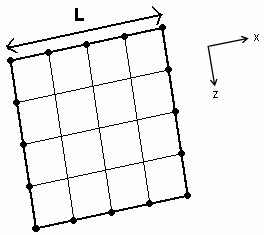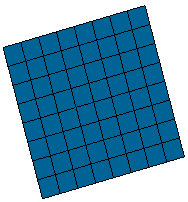This test lets you check analysis results for a free thin square plate, in the context of a Free Frequency Case. You will use 2D meshes.
This test validates the following attributes:
- Rigid body modes (3 modes)
- Repeated eigen values
- Cinematically incomplete suppressions.
Reference:
NAFEMS-Glasgow, BENCHMARK newsletter, April 1989, p.17.
 Specifications
Specifications
Geometry Specifications
|
Length: |
|
|
Thickness: |
Analysis Specifications
|
Young Modulus (material): |
|
|
Poisson's Ratio (material): |
|
|
Density: |
|
|
Mesh Specifications:
|
|
|
Restraints (User-defined): The structure is free, hence the boundary conditions
are: |
|
|
The Frequency case must be computed in Lanczos method with Shift Auto. |
 Results
Results
The computed results present the frequency of the six modes after the three rigid body modes.
The normalized results are the computed results divided by the reference solution.
|
Mode |
Reference value |
Values |
|||||||
|
Linear triangle |
Linear quadrangle |
Parabolic triangle |
Parabolic quadrangle |
||||||
|
|
|
|
|
||||||
|
Computed |
Normalized |
Computed |
Normalized |
Computed |
Normalized |
Computed |
Normalized |
||
|
4 |
1.622 |
1.614 |
0.995 |
1.624 |
1.001 |
1.584 |
0.977 |
1.622 |
1.000 |
|
5 |
2.360 |
2.379 |
1.008 |
2.389 |
1.012 |
2.376 |
1.007 |
2.367 |
1.003 |
|
6 |
2.922 |
2.961 |
1.013 |
2.980 |
1.020 |
2.950 |
1.010 |
2.935 |
1.004 |
|
7 |
4.233 |
4.229 |
0.999 |
4.252 |
1.004 |
4.135 |
0.977 |
4.174 |
0.986 |
|
8 |
4.233 |
4.231 |
1.000 |
4.252 |
1.004 |
4.149 |
0.980 |
4.174 |
0.986 |
|
9 |
7.416 |
7.653 |
1.032 |
7.793 |
1.051 |
7.439 |
1.003 |
7.550 |
1.018 |
To Perform the Test
The Free_Thin_Square_Plate_QD4.CATAnalysis document presents a complete analysis of this case, computed with a mesh formed of linear quadrangle elements (QD4).
To compute the case with other elements (QD8, TR3 and TR6), proceed as follow:
-
Open the CATAnalysis document.
-
In the Advanced Meshing Tools workbench, replace the mesh specifications as indicated above.
-
In the Generative Structural Analysis workbench, compute the case.

